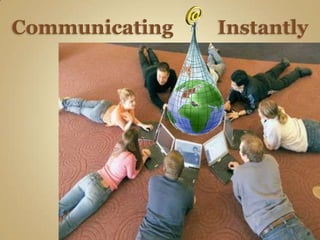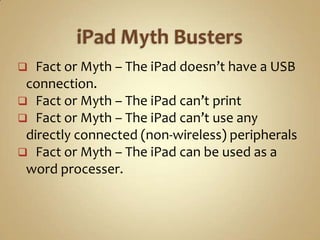DC3 Opening Session
- 4. Listeningto @digitalsandbox1 iPad College In-service “The Connected Learning Approach”#DC3
- 8. Communicating Instantly
- 9. A man who carries a cat by the tail learns something he can learn in no other way. Mark Twain First results of change may be resistance.
- 10. How well do you have to understand the technology to use it in your classroom? It is not about understanding how to use a computer, it is about understanding how to access information, and use digital tools to create new forms of connected learning.
- 13. In 1852, Horace Mann the Father of American Education adopts the Prussian education system in Massachusetts.
- 28. 240 Years Later
- 29. 50 Years Later
- 30. 19 Years Later
- 31. 14 Years Later
- 32. 7 Years Later
- 33. 2 Years Later
- 34. What Do We Do, with all of these technology tools?”
- 39. Fact or Myth – The iPad is not capable of creating documents, you can only engage with apps. Fact or Myth – The iPads will not allow students to save their work. Fact or Myth – The iPad is too difficult to type on; our students need to know how to type on a normal key board. Fact or Myth – The iPads cannot function with flash.
- 40. Fact or Myth – The iPad doesn’t have a USB connection. Fact or Myth – The iPad can’t print Fact or Myth – The iPad can’t use any directly connected (non-wireless) peripherals Fact or Myth – The iPad can be used as a word processer.
- 41. Number Off 1 to 3
- 42. The Evolution of Classroom Technology edudemic Michael Moe Eisummit (29.3 Mb) Download E-Learning Spaces ePub Generation Connected Learning
Editor's Notes
- Mike King is the recipient of the 2012 Digital Principal Award sponsored by the National Association of Secondary School Principals (NASSP). The award was created to 'honor principals who exhibit bold, creative leadership in their drive to harness the potential of new technologies to further learning goals.' The Digital Principal Award is designed to 'showcase models of leadership that encourage the use of technology in instruction and for principals’ own professional use.' Links to the right are referenced as part of the application process. NASSP, in an announcement of the Digital Principal Award recipients stated that, "During Mike King’s 32 years in education, his schools have been recognized with an Oklahoma Medal of Excellence and National Blue Ribbon, among other honors. While at Dodge City Middle School the school has been recognized by the Kansas Association of Middle School Administration as a Gold Standard High Performance School in both math and reading in 2010 and in 2011. The school was also recognized as a KAMSA Exemplary Middle School in 2010 and as the Middle School of the Year finalist in 2011 and NASSP National Breaking Ranks Showcase School in 2012. Additionally the school has been recognized by the Kansas State Department of Education as a Standard of Excellence school in both seventh and eighth grade reading. He has also been individually recognized as the 2005 finalist for the Oklahoma Medal of Excellence Award Educational Administration and was a finalist for the 2005 Association of Professional Oklahoma Educators Foundation Award in Educational Administration. In 2010 he was named as the Administrator of the year by the Kansas Gifted and Creative Association. This success is inseparable from him commitment to advancing learning with technology and his firm belief that digital tools can help students unleash their creativity. The role of the educator, King believes, is to facilitate that process and help students use digital tools responsibly. King is a prolific author, most recently focusing on the flipped classroom and the textbook of the future. To learn more about Mike you can review his Digital Portfolio Blog where you will find links to his presentations, productions and publications.
- Prior to this webinar I provided a tweet announcement using the following hash tags.
- Enter into your browser the following url http://epubgeneration.weebly.com
- The new challenge for education is in information consumption as literacy is redefined through connected learning experiences and in ways that students access the vast warehouses of digital content. To face these challenges, education must come to grips with how our learning culture is changing. It is believed we're living at the instant of the greatest change in human communication history.
- We now have the capability of communicating instantly globally. These incremental changes aren’t about how students learn, or about the pencils, papers, and textbooks. It is about how people are working. People today work with laptops and word processing tools. It is not so much about going to the library or reading a textbook. It is how students can research the riches of the world as they're stored on the web. This is about the new libraries of consumable text. It is about the new workspaces that have created the possibility of sharing knowledge infinitely.
- Mark Twain’s statement of “A man who carries a cat by the tail learns something he can learn in no other way, “is indicative of someone who looks at change in a haphazard way. A typical response from anyone when asked why they must make changes is, just to simply ignore it, we ignore what we do not understand. This means that knowing change will confront us with certain tendencies to focus on other issues; the ones we do understand. These tendencies are providing a foreground for what we do understand about traditional instruction and a background for what we do not understand about applying digital literacy skills to instruction. The reason this occurs is that we cannot find practical ways to deal with what we do not understand about the importance of digital literacy. In each case, when confronting change you may be caring a cat by their tail. Change is a process. Change has roadblocks and each of these two factors will be a part of today’s session. How do you avoid carrying a cat by its tail when confronting change?
- This lends us to the essential question, "How well do you have to understand the technology to use it in your classroom?" To answer the question, it is not about understanding how to use a computer, it is about understanding how to access information, and use digital tools to create new forms of connected learning.
- In our opening session we will take a two minute glace of how technology has influenced our lives both from an educational prospective. Secondly we will look at the counterbalance of what really happened to education while growing professionally on the edge of the technology evolution..
- One point, that Tony Wagner makes about the need for educational change is brought out in his book, The Global Achievement Gap, Wagner states, "The world is changing at a faster rate than ever before, even the great expansion of the Roman Empire will not compare to the evolution of technologies now being experienced in our generation." Let's take a short look at this change from in 1865!! until now.In the next few slides I will prove you with some statistics on change. These statistics are designed to bring out an awareness of where we are today as a society as we address the needed changes in education.
- what really happened to education while growing professionally on the edge of the technology evolution..
- In this picture you are seeing one of the first printers I used during my first year of teaching. I am using the term crank technology because this was the machine that made the teacher workroom popular. This was the evolution of print technology that made everyone fight for a position in line. It is not because the technology could multiply worksheets at fast rate that made this mechanized machine a popular wonder among teachers. I soon found out that it was the liquid it required to make the copies that made it so popular. This was the machine that gave you the courage and mind buzz to meet your first hour class. In fact many a lunch period was purposefully missed and many a teacher stayed late to experience multiple copies. These were also the years where parent volunteers became a popular component among schools across the country.










































